The Slapstick Joy of Speculative Horror Comedy
লেখক: Stuti Kute
শিল্পী: Team Kalpabiswa
Mel Brooke’s 1974 work ‘Young Frankenstein’ features the delectable Gene Wilder in the role of the grandson of Dr Frankenstein, also Dr Frankenstein. Shelley’s seminal work (Frankenstein, 1818) laid the groundwork for horror as a genre in the nineteenth century, and when it is adapted to this absurdist comedy set in the atmospheric eeriness of Frankenstein’s Castle, the band of odd characters and their grotesquely comic interactions gives us gems like these: a student asks the junior Dr Frankenstein, “but what about your grandfather’s work, sir?” The ensuing response breaks viewer immersion brilliantly as Dr Frankenstein emphatically responds to the student, “My grandfather’s work was doo-doo!”.
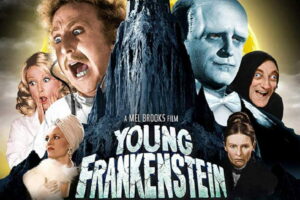
The adolescence of horror-comedy, after skirting around subversive adaptations of classic horror, gets us to the Beetlejuice (with Michael Keaton’s legendary, “It Show Time!”) and the Addams Family era (“They’re creepy and they’re kooky, mysterious and spooky, they’re altogether ooky.”) where the viewer begins to question the inherent terribleness of the terrifying because how indeed, can you not love Gomez and Morticia Addams (especially the 1991 cast)? We also have Ghostbusters (1984), Army of Darkness, 1992 (“This is my boomstick!” declares Ash William beckoning to the shotgun he holds), Evil Dead (1981), and others in a genre we can club into the umbrella term of ‘speculative horror-comedy’ – marking a flight from realism into the fantastical and allowing for a broader spectrum of subgenre representation (like satire, philosophy) in one neat package. This essay is a bird’s eye view of the genre, delving into the formative nature of why it works and keeps working and what parallels it holds in both classic and contemporary contexts resonating across decades.
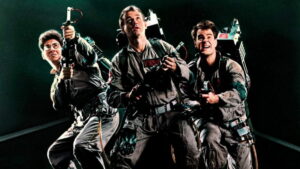
Pastiche vs Parody
Squeal with laughter or scream in terror, either way, the stereotypical popcorn is to be launched in the air, a sign that the content on the big screen is thoroughly immersive and enjoyable to the viewer. Not considering, of course, that said stereotype came into effect long before the movie theatres were out to rob you. As a byproduct of the culture of the late 90s and early 2000s, my earliest memory of this particular subgenre of Horror-Comedy was the Scary Movie series. Being too young to understand the humour in it, the man with the mask and the knife who jumps out from behind the curtains with the cheesy background music was terrifying. But the viewer grew up, and the nightmares about the crawling hand from Evil Dead 2 (1987) turned into a snickering smugness. Hence, when as viewers and academics, we look at these films as adaptations or homages to a certain genre of horror, the question arises about what happens when this homage subverts genre expectations to a level where it goes from pastiche (a medley of era styles meant to be a tribute).to absolute parody. The Scary Movies are the perfect example of the latter, a cultural parody of the ‘phone call from your killer’ sub-genre of the 70s and the 80s – taking elements from a selection of movies released in the preceding decades and parodying them with a proud perversion. A fitting example of this would be the recreation of The Exorcist (1973) in Scary Movie 2 (2001) which goes something like this: Father stands over the possessed girl (a recall to the famous scene from The Exorcist), “Let us pray, to the defender of human rights, look down with pity upon this, your servant.” Followed by a select list of expletives from the possessed girl who then shuts up immediately when Father tosses a tictac in her mouth. This scene is absurdist perfection. Yet, it succeeds in evoking a similar feeling in the pit of your stomach of the uncanny terror of the original—a success of intertextuality.
Stuart Gordon, director of From the Beyond (1986) and Re-Animator (1985) stated in an interview: “When Hitchcock referred to Psycho, he always referred to it as a comedy. It took seeing it three or four times before I started picking up on it as a comedy. He said that there was a very fine line between getting someone to laugh and getting someone to scream. One thing I’ve learned is that laughter is the antidote. When you don’t think you have to laugh, then you are basically blowing away the intensity. You have to be careful when you do that, you don’t want to be laughing at the expense of the fright. It’s best if you can alternate between the two, build up the tension, and then release it with a laugh. It is a double degree of challenge. You’re walking a tightrope, and if something becomes inadvertently funny, the whole thing is over. The thing I have found is that you’ll never find an audience that wants to laugh more than a horror audience.”
However counterintuitive it may seem; laughter and terror do bear a twisted connection with each other that is far too complex to be dealt with in such a short essay. Robert Bloch, the author of the novel Psycho (1959) has spoken about Comedy and Horror being the opposite sides of the same coin, dealing with the unexpected and the grotesque but provoking different, yet equally rousing physical reactions. We can also attribute this to a general observation that Horror-Comedy often also features an exaggerated display of sexual elements—succeeding in aiding the suspension of disbelief further and adding to the absurd comic effect which is unsurprising because human beings have a penchant for finding sex and sex-related jokes very funny.
This cognitive overlap, whether it be as a defense against the evoked fear of horror or a natural reaction to the fanciful and otherworldly – there is no doubt that the popularity of the genre is growing at a comically frightening rate.
Fleshly Horrors: Zombies do have a Sense of Humour
The trope of the Zombie Apocalypse has carved a respectable space for itself in the Sci-Fi/Horror genre. It plays with our instinctual fear of death and diseases, taking it to the next level with the concept of the ‘infectious undead’ where you can catch your ‘undeath’ instead of respectfully passing away to oblivion and memory. I remember being 15 and telling my unsuspecting English teacher, “I love zombies!” This universal fascination with zombies is but our innate discomfort with bodily fluids and decay manifesting into a morbid curiosity of the young. Couple that with the sheer physical comedy of the slow-walking braindead ghoul, and we have on our hands some pretty nifty cinematic gems. A recent example of this particular subgenre of ‘flesh-hungry-zombies-in-a-small-town’ is The Dead Don’t Die (2019), featuring the formidable Tilda Swinton and Bill Murray among other illustrious cast members. The film takes the trope of small-town zombies and turns it into a comedic masterpiece. “They gravitate towards things they did when they’re alive.” Cutting to a shot of a formerly blonde female zombie cooing with the drawl of the undead—“chardonnaaayyyy”.
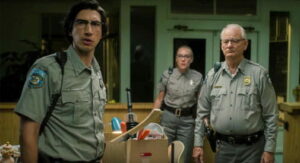
We as viewers, of course, have come to love zombies in all and all forms. Where Resident Evil (2002) failed to deliver in its non-existent comedic timing (we jest), the zombies then reached Georgian England in the classic adaptation of the classic Jane Austen romance, Pride and Prejudice and Zombies (2009). The traditional serenity of Jane Austen’s novels, the genteel society, the turns about the room, the catty aunts and dashing gentlemen over for tea crossed over and were challenged with the gore and violence of a sudden zombie outbreak. The juxtaposition of disparate genres shocks and delights, resulting in an over-the-top satirisation of two very different tropes (the horror and the classic romance) and creating a truly postmodern period piece that I am positive Jane Austen would have loved.
Fleshly Horrors Turn Desi Too!
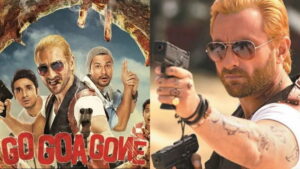
This specific subgenre has also crossed over to Bollywood and the regional cinema of India. An excellent example of this would be Go Goa Gone (2013) playing on the bachelor and booze archetype of films with a dash of zombie island and shotguns. The opening scene of the film features Cheeranjeevi’s Golimar song (Donga, 1985), a direct adaptation of Michael Jackson’s Thriller (1982) chock-full of zombies’ pop and locking—a meta callback and a hark forward to the plot to come (Abed Nadir would’ve loved this). Three friends high on ‘Babaji ki booti’ faced with the sudden onslaught of a zombie outbreak is nothing but a joy to watch, especially with the archetypical (faux) Russian thug in the form of Saif Ali Khan’s Boris who turns out to be a regular thug from Delhi—“Delhi se hu, bh*****d!”, the dialogue that breaks immersive horror tension as they scout the islands for the undead ghouls and parallelly question the authenticity of his Russian-ness. What makes this film so noteworthy in this particular genre is that it performs a double subversion: that of the Dil Chahta Hai (2001) three friends in Goa trope and the zombie outbreak narrative trope.
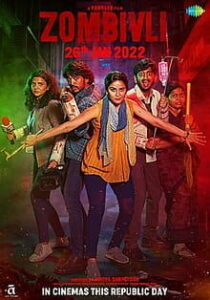
Another one of my personal favourites that makes its way to this list is the Marathi hit Zombivli (2022): a zombie outbreak in Dombivli, a suburb of Mumbai featuring all the regular shenanigans of the neighbourhood youth and Mumbai gunda leaders (and Mumbai police) caught in the fresh hell of this unimagined but hilarious horror. “This is what happens when you eat Chinese Bhel” as a response to a zombie sighting might be the most sociologically accurate observation of Mumbai life. A striking observation between these two desi selections is the focus on the titular geography of it. Be it Goa or Dombivli, it warrants an investigation that we currently will not get into. But if it were to be a one-line conclusion born of amateur observations, it would be that we Indians do attach a great deal of safety and sentimentality to physical spaces, allowing an easy avenue for horror.
The ubiquity of the trope as well as our fascination with it is apparent. In comparison to the other subsects of the horror-comedy, the zombies are relatively easier to ridicule. They’re purely physical horror (the rot, the decay, the reanimated corpsehood) without the air of ghostly spirits, ancient demons, exorcisms, or psychotic sentient murderers. This allows for the more clichéd subversions of narrative: think the undead slow-walking behind the still-lives with their arms held up and bloody drool staining their rotten faces or that one member of the fighting team who’s hiding a zombie bite, a friendly time bomb about to contaminate the safe area. The only hope we laymen have during a Zombie Apocalypse is that at least we can outrun them.
This was true only until the Koreans decided to make their zombies run at full speed (Train to Busan, 2016), forever taking away our last bastions of imagined security. Terrifying, and not funny.
The Horror Comedy genre has thrived parallel to the rise of alternative cinema. But by no means does this mean that it is a new genre. Where there have been generic tropes, there have been smart and funny people of the era ridiculing these funny tropes. Jane Austen’s Northanger Abbey (1817) poked fun at the rise and popularity of the gothic genre among the middle class quite openly. Mary Shelley wrote Frankenstein in 1818. In the following decades, renditions of Frankenstein came about mixing ream-splitting laughter and lady-blushing horror: Frank-in-Steam (or The Modern Promise to Pay) in 1824 or Frankenstitch, The Needle Prometheus in the coming years. This in no way denigrates the importance and the formative nature of the original but adds to its immortality. How indeed could we have the lighthearted Hotel Transylvania with the most lovable Dracula without Bram Stoker’s original?
All in all, the Horror-Comedy touches a rather profound chord. At the risk of getting philosophical, an analogy is underway: that of the clown. Made to delight and entertain, the clown skirts that liminal space between the comforting and the eerie in ways unexplainable (hello, Stephen King). Dolls, usually objects of joy, comfort, and domesticity also give way to the many horror dolls of the classic horror genre, like Chucky or Annabelle. This is food for thought that I leave you with, as the next R-rated Horror Comedy awaits my airborne-popcorn appreciation.
References
Carroll, Noël. “Horror and Humor.” The Journal of Aesthetics and Art Criticism, vol. 57, no. 2, 1999, pp. 145–60. JSTOR, https://doi.org/10.2307/432309. Accessed 11 Sept. 2024.
Says: Trav28. “Stuart Gordon: The 1986 Interview.” MULTIGLOM, 1 Jan. 2018, multiglom.com/2010/09/05/stuart-gordon-the-1986-interview/. Accessed 11 Sept. 2024.
Tags: English Section, Stuti Kute, নবম বর্ষ প্রথম সংখ্যা

